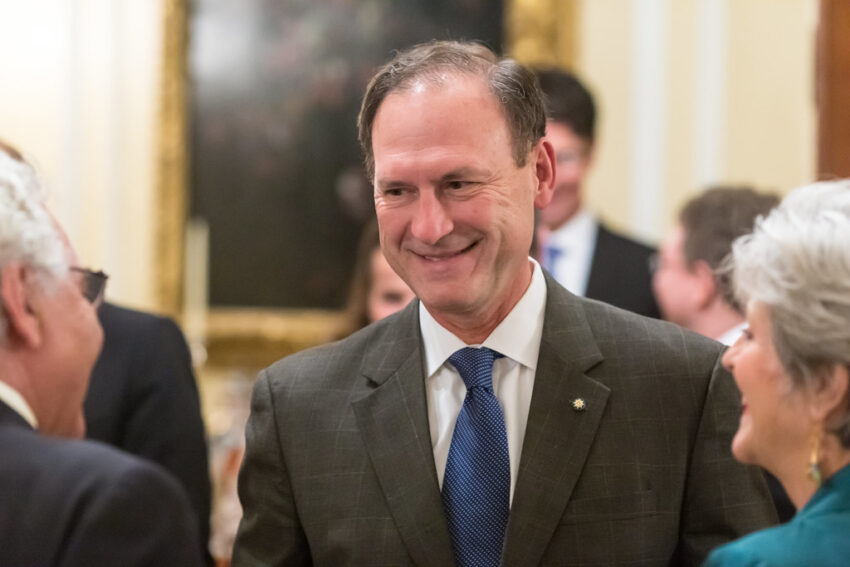Tomorrow is the third anniversary of Dobbs v. Jackson Women’s Health Organization, a decision that genuinely deserves the designation of “landmark.” Worth recalling is that before a draft of the decision was leaked to Politico and published on May 2, it was not widely assumed that the justices would use Mississippi’s 15 week protective law to overturn the horrific Roe v. Wade decision. In a 5-1-3 decision, the Supreme Court did just that.
Whatever the motivation—and most observers assumed it was intended to try to intimidate the justices—the source was never identified. But in May 2025, the FBI announced that it is reopening an investigation into the 2022 leak of the draft decision.
On the June 24th anniversary, I’ll offer a few comments on a discussion Justice Alito had with Peter Robinson of the Hoover Institute for what clues it offers to his judicial thinking in general, Dobbs in particular.
Please follow LifeNews on Rumble for the latest pro-life videos.
A few days after Dobbs was handed down and I had a chance to digest the decision, I offered my layman’s analysis of the framework of the decision. Drawing on quotes from the opinion, I looked at four points.
#1. There is no foundation.
“The dissent is very candid that it cannot show that a constitutional right to abortion has any foundation, let alone a ‘deeply rooted’” one, “in this Nation’s history and tradition.’ The dissent does not identify any pre-Roe authority that supports such a right—no state constitutional provision or statute, no federal or state judicial precedent, not even a scholarly treatise”
#2. “Mystery of Life” passage, Part Two, meets bad history. In the 1992 Casey decision, the plurality invoked gibberish so untethered to the Constitution it was reminiscent of Justice Blackmun’s original Roe v. Wade decision. As Alito wrote
The largely limitless reach of the dissenters’ standard is illustrated by the way they apply it here. First, if the “long sweep of history” imposes any restraint on the recognition of unenumerated rights, then Roe was surely wrong, since abortion was never allowed (except to save the life of the mother) in a majority of States for over 100 years before that decision was handed down.
Second, it is impossible to defend Roe based on prior precedent because all of the precedents Roe cited, including Griswold and
Eisenstadt, were critically different for a reason that we have explained: None of those cases involved the destruction of what Roe called “potential life.” So without support in history or relevant precedent, Roe’s reasoning cannot be defended even under the dissent’s proposed test, and the dissent is forced to rely solely on the fact that a constitutional right to abortion was recognized in Roe and later decisions that accepted Roe’s interpretation. Under the doctrine of stare decisis, those precedents are entitled to careful and respectful consideration, and we engage in that analysis below. But as the Court has reiterated time and time again, adherence to precedent is not “‘an inexorable command.’” There are occasions when past decisions should be overruled, and as we will explain, this is one of them.
#3. Failure to realize that abortion is fundamentally different—that states have a legitimate interest in “potential life.”
The most striking feature of the dissent is the absence of any serious discussion of the legitimacy of the States’ interest in protecting fetal life. This is evident in the analogy that the dissent draws between the abortion right and the rights recognized in Griswold (contraception),
Eisenstadt (same), Lawrence ( sexual conduct with member of the same sex), and Obergefell (same-sex marriage). Perhaps this is designed to stoke unfounded fear that our decision will imperil those other rights, but the dissent’s analogy is objectionable for a more important reason: what it reveals about the dissent’s views on the protection of what Roe called “potential life.” The exercise of the rights at issue in Griswold, Eisenstadt,
Lawrence, and Obergefell does not destroy a “potential life,” but an abortion has that effect. So if the rights at issue in those cases are fundamentally the same as the right recognized in Roe and Casey, the implication is clear: The Constitution does not permit the States to regard the destruction of a “potential life” as a matter of any significance. That view is evident throughout the dissent.
#4. Dobbs resembles other Supreme Court decisions now universally acknowledged as “infamous.”
“Like the infamous decision in Plessy v. Ferguson, Roe was also egregiously wrong and on a collision course with the Constitution from the day it was decided. Casey perpetuated its errors, calling both sides of the national controversy to resolve their debate, but in doing so, Casey necessarily declared a winning side. Those on the losing side—those who sought to advance the State’s interest in fetal life—could no longer seek to persuade their elected representatives to adopt policies consistent with their views.”
Justice Alito, of course, was widely criticized for his integrity and willingness to see Roe for the ghastly mistake it was. But he was right three years ago and he is right today.
LifeNews.com Note: Dave Andrusko is the editor of National Right to Life News and an author and editor of several books on abortion topics. This post originally appeared in at National Right to Life News Today —- an online column on pro-life issues.
The post Justice Alito Was Right: There is No Right to Abortion in the Constitution appeared first on LifeNews.com.
Click this link for the original source of this article.
Author: Dave Andrusko
This content is courtesy of, and owned and copyrighted by, https://www.lifenews.com and its author. This content is made available by use of the public RSS feed offered by the host site and is used for educational purposes only. If you are the author or represent the host site and would like this content removed now and in the future, please contact USSANews.com using the email address in the Contact page found in the website menu.








